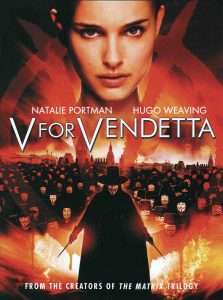REVIEW: V for Vendetta
Remember, remember the fifth of November. It’s time for your annual rewatch of V for Vendetta. Oh, wait, no, that’s just my version. Watching V for Vendetta has been my little Fifth of November tradition since the early 2000s. It occurs to me, like the Alan Moore comic of the same name, that the V for Vendetta movie ticks many boxes of things grimdark fans may enjoy. If you haven’t picked up this graphic novel or watched the film, I humbly suggest them for your autumn reading pile or a movie night.
 For those who don’t know, the rhyme is ‘Remember, remember, the fifth of November—gunpowder, treason, and plot. I see no reason why gunpowder treason should ever be forgot.’ It commemorates the Gunpowder Plot when, in 1605, Guy Fawkes and his conspirators attempted to blow up the House of Lords and the King on that fateful fifth of November night.
For those who don’t know, the rhyme is ‘Remember, remember, the fifth of November—gunpowder, treason, and plot. I see no reason why gunpowder treason should ever be forgot.’ It commemorates the Gunpowder Plot when, in 1605, Guy Fawkes and his conspirators attempted to blow up the House of Lords and the King on that fateful fifth of November night.
As a brief history lesson, and because it is pretty grim and dark, we Brits burn effigies of poor old Guy on a bonfire each the fifth of November (and let off fireworks terrifying the local four-legged residents) but Mr. Fawkes wasn’t burnt at the stake as this method of execution was only used for women. Lucky us. Instead, Guy was sentenced to be hung, drawn, and quartered, where he would have been hung until nearly dead, then taken down from the gallows, emasculated, disembowelled, beheaded and then hacked into four chunks. Supposedly, Guy “accidentally” died during the hanging part of this torturous execution, but still. Awful.
V for Vendetta opens with the voice-over of this rhyme and a brief historical recap, with Evey Hammond, the movie’s leading lady played by Natalie Portman, pointing out that everyone remembers this rhyme, this idea of revolution, and the name of Guy Fawkes as a revolutionary, but no one remembers him as a man. This is an idea that will reoccur throughout the movie.
Set in a dystopian near future, V for Vendetta has a far-right totalitarian government. Movements are restricted, food and water are rationed, and state-controlled media churns out propaganda to the masses. In addition to leading lady Evey Hammond, the main man is V, played to perfection by Hugo Weaving. V is a masked vigilante with a violent vendetta. Like his historical inspiration, V plans to blow up parliament on the fifth of November as a catalyst for change.
Although not entirely like the graphic novel that inspired it (movie V is more of a romantic freedom fighter than a ruthless anarchist, and Evey’s traumatic life and more traumatic transformation are toned down for film watchers), V for Vendetta is a better adaptation than some of Moore’s other graphic novels which have been treated to a movie makeover. It may have been the Thatcher era that inspired Moore, but even now, nearly 20 years after the film was released, the fictional Britain portrayed here doesn’t feel like it is an entirely unrealistic scenario. That thought alone is enough to give a slight pause while watching.
With a screenplay by the Wachowski siblings and the directorial debut of James McTeigue, who was their assistant director on The Matrix, it is unsurprising that, at times, the audience can see style parallels between The Matrix and V for Vendetta. The final fight scene of the movie is particularly reminiscent of this, but it still stands out to me as one of the film’s memorable moments.
The casting is my favourite part of V for Vendetta, except for Natalie Portman’s questionable British accent. Hugo Weaving is a magnetic screen presence, and I still remember the awe with which I watched him on the big screen as V all those years ago. We never see his face in any of the guises in which he appears, and with only his voice and physical presence, Weaving steals every scene he is in. Some stellar actors are in supporting roles too, including John Hurt as Chancellor Sutcliffe, Stephen Fry as gay TV executive Gordon Dietrich, and Stephen Rea and Rupert Graves as disillusioned police officers investigating V.
V may have been turned into the unlikely hero of the film adaptation of V for Vendetta, but he still has some questionable morals. Lines like “violence can be used for good” and torturing one of the people closest to him still suggest that the ends always justify the means here. Speaking of which, the ending of V for Vendetta, where parliament explodes to classical music, and the hundreds of “V” s unmask themselves to reveal the victims of the corrupt government, is another of the many visually remarkable moments in the film.
As with almost all adaptations, part of me wants to point out that Moore’s graphic novel is “better” than McTeigue’s version of V for Vendetta, but as this is one of my favourite films, I shan’t do that too loudly. Every rewatch, I pick up on something different (I haven’t even had a chance to touch on the Valerie sub-plot and its portrayal here), and the fact that the film still feels entertaining, relevant, and politically significant today should speak volumes about the standard of V for Vendetta.
Watch V for VendettaThe post REVIEW: V for Vendetta appeared first on Grimdark Magazine.



